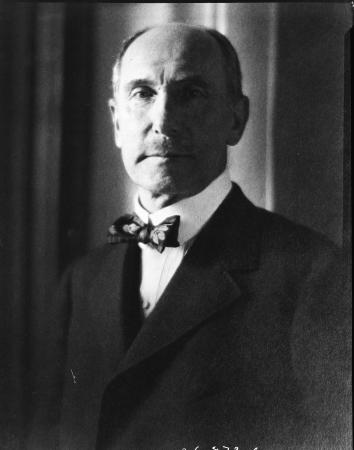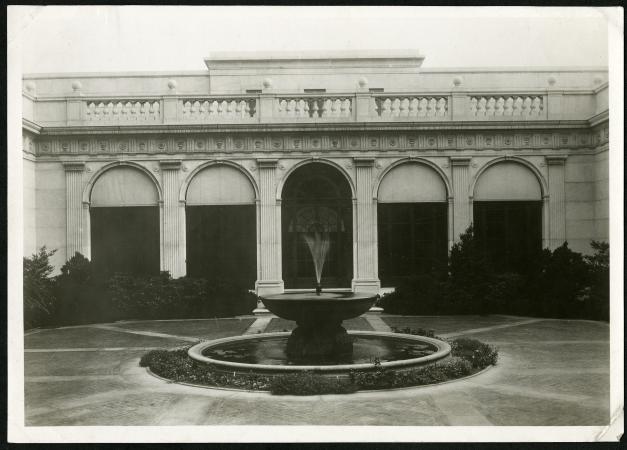On this day in 1912, United States National Museum visitors got a a sneak peek of the collections donated by industrialist Charles Freer that would become the foundation for the Freer Gallery of Art, which opened in 1923. In honor of that day, let’s take a listen to The World Is Yours episode about the Freer Gallery, which aired on December 20, 1936. This episode stands apart from the others that came before it for the mere fact it is set at a Smithsonian space other than the United States National Museum.

The episode starts with a couple at the Freer Gallery remarking at the overwhelming feeling of peace and serenity they feel looking at the objects. A fellow visitor steps forward and offers to guide them through the gallery, because he is familiar with the objects. The first object they view is a Japanese screen of six panels. The visitor points out different images on the panels which indicate that the screen depicts a puppet show and offers to translate the panels for the other guests. What follows is a lengthy dramatization reenacting the story of a man named Tsuneyo and his wife, who have fallen out of favor with the government. The couple are nearing poverty when a monk stops by, seeking shelter for the night. Tsuneyo and his wife take in the man, and ultimately burn their last beloved dwarf trees to provide warmth for the monk. Later, Tsuneyo is called to the palace and is rewarded for his kindness to the monk who was actually a prince in disguise.
From there, the visitor-turned-guide leads the couple towards a Chinese silk roll.
Listen here as the visitors discuss the silk roll.
[Man] It looks very old.
[Guide] It was painted 700 years ago.
[Woman] Impossible! Why the little human figures stand out too clearly.
[Man] Were those figures done with a pen?
[Guide] No, with a brush.
[Woman] Some of those lines are as thin as a hair.
[Man] The silk is such a beautiful, rich brown.
[Woman] Oh, and I love those black and gold drawings of people against the brown silk. Does this roll tell a story also?
[Guide] Yes, one of the oldest and loveliest stories in Chinese legend. The poem by Cao Zhi called The Nymph of the Luo River.

A dramatization of the images depicted on the silk roll follows. Once that concludes, the guide urges the visitors to continue through the galleries toward rooms containing the artwork of American artist James McNeill Whistler. While viewing a self-portrait of Whistler, the artist, himself, materializes and leads the visitors through the rest of the episode. He starts with a brief history of his time in Paris where he painted his self-portrait, and when asked about love interests during that time, he speaks of a model he nicknamed the Tigress. This is followed by a dramatization of a party at Whistler’s apartment that is broken up by his landlord demanding his rent, after which he kicks all the partygoers out, but the Tigress stays behind to be his muse.
Whistler then turns the visitors’ attention to another painting called “The Music Room” from his time in London. He discusses how his entire conception of art was to make each painting have the kind of balance and harmony in color that a piece of music has in sound. Whistler shows a continuation of his theory in a painting of women on a balcony. He states that he was delighted with Japanese artists and techniques because they seemed to understand how to blend color better than others.
Listen here as Whistler leads the visitors to the Peacock Room.
[Whistler] The more I experimented with Japanese motif, the more I became fascinated with the possibility of using oriental decorations for a room. And one day in 1876, I visited the dining room of Mr. Frederick Leyland’s London house. I remember he said to me…
[Leyland] Well, Whistler, what do you think of the room now?
[Whistler] It has all the delicacy of a butcher shop.
[Leyland] Wha, what?
[Whistler] Eh gods, man. I paint a picture, a symphony in rose and silver, fragile as a Japanese vase, and you, you put it in a room like this.
[Leyland] Well, I don’t see why…
[Whistler] That painting of mine is in rose and silver but look at your room! Leather walls with red flowers on them, the rug full of red. No, no Leyland, it won’t do, it won’t do!
[musical transition]
[Woman] What happened?
[Whistler] I changed the room into what is now known as the Peacock Room. I visualized the entire room in blue and gold, based both in color and design on the blue and gold peacock.
[Woman] Oh, I’d love to have seen it.
[Whistler] Well, I’ll show it to you.
[Woman] How?
[Man] Really?
[Whistler] Mr. Freer bought the room years later and brought it from London to this museum. Follow me. Ah yes, here we are, right through this doorway. There, look.
[Woman] Oh, how glorious.
[Man] Oh those beautiful peacocks on the walls and shutters.
[Woman] Blue and gold everywhere.
[Whistler] You notice how the blue and gold on the ceiling, the blue and gold peacocks harmonize with my painting on the wall.
[Man] Yes, perfectly. The painting becomes the center of attention.
[Woman] It’s the most beautiful room I’ve ever seen.
[Man] It must have made you very famous.
[Whistler] From then on, my name was on everyone’s tongue.
Whistler goes on to talk about how he once sued famed art critic John Ruskin for libel after he claimed that a patron paid too much for one of Whistler’s paintings followed by a reenactment of Whistler’s conversation with the barrister at the trial. After the dramatization, he then discusses how underappreciated his work was by art critics around the world and that he was often poor as a result. It wasn’t until he was in his fifties that his work began to be recognized for what it was. At that point, he fell in love and married, though his wife died from cancer eight years later.
The last painting that Whistler shows the visitors is one that he painted towards the end of his life. He describes it as being more tender and delicate as life softened him towards the end. He describes how he had immortalized himself with his paintings, yet fame was bittersweet because his wife had died before him. With that last melancholy thought, Whistler’s character fades away from the visitors and the program ends.
Check back next month for a look at another episode of The World Is Yours!
Related Collections
- Smithsonian Institution Sound Recordings, circa 1915-1941, Accession 05-142, Smithsonian Institution Archives
Related Resources
- National Museum of Asian Art
- Freer Gallery of Art, Smithsonian Institution Archives
Produced by the Smithsonian Institution Archives. For copyright questions, please see the Terms of Use.

Leave a Comment